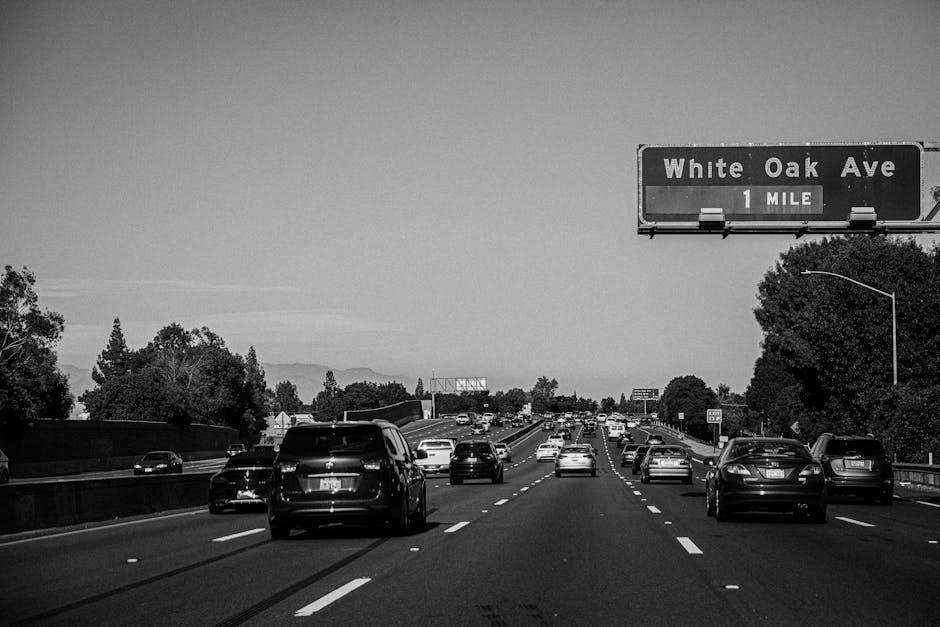highway and expressway guide signs are:
uniform systems providing directions and information to drivers on highways and expressways effectively and safely always using specific colors and designs for guidance and navigation purposes only there.
Overview of Guide Sign Standards
highway and expressway guide signs are: uniform systems providing directions and information to drivers on highways and expressways effectively and safely always using specific colors and designs for guidance and navigation purposes only there. The standards for guide signs are outlined in the Manual, which provides a uniform and effective system of signing for high-volume, high-speed motor vehicle traffic on freeways and expressways. The provisions of this Chapter provide a uniform system of signing, and the requirements and specifications for expressway signing exceed those for conventional roads. Guide signs for freeways and expressways are primarily identified by the name of the sign rather than by an assigned sign designation. The Standard Highway Signs book provides specifications for all signs, including those for freeways and expressways, and Iowa Dept. of Transportation Policy 620.10 provides further explanation for freeway and expressway guide signing. The standards ensure that guide signs are consistent and easy to understand, providing clear directions and information to drivers. The goal of the standards is to provide a safe and efficient system of signing for high-volume, high-speed traffic. The standards are used to guide the design and installation of guide signs on highways and expressways.

Classification of Guide Signs
highway and expressway guide signs are: categorized into types based on destination and route information always providing clear guidance to drivers on highways and expressways using specific classifications only there.
Design Characteristics of Guide Signs
highway and expressway guide signs are: designed with specific characteristics to ensure clarity and visibility, including large lettering, symbols, and arrows to provide long visibility distances and clear guidance to drivers on highways and expressways.
these design characteristics are crucial in providing effective guidance to drivers, especially on high-speed roads where drivers have limited time to react and make decisions, and must be able to quickly and easily read and understand the information on the signs.
the design of guide signs must also take into account the speed and volume of traffic, as well as the surrounding environment and potential distractions, to ensure that the signs are visible and legible to all drivers, and that the information on the signs is clear and concise.
overall, the design characteristics of guide signs play a critical role in ensuring the safe and efficient movement of traffic on highways and expressways, and must be carefully considered and implemented to achieve this goal, using specific colors and designs for guidance and navigation purposes only there always.

Color of Guide Signs
highway and expressway guide signs are: having white letters and symbols on a green background for guidance and navigation purposes only always using specific colors for effective visibility.
Standardization of Guide Signs
highway and expressway guide signs are: standardized to ensure uniformity and consistency in design, color, and messaging to provide clear guidance to drivers, the standardization of guide signs is crucial for effective navigation and safety on highways and expressways.
the standardization process involves establishing specific guidelines and regulations for the design, installation, and maintenance of guide signs, this includes specifying the types of signs to be used, their size, shape, color, and messaging, as well as the materials and manufacturing processes to be employed.
the goal of standardization is to create a cohesive and recognizable system of guide signs that can be easily understood by drivers, regardless of their location or the highway they are traveling on, by standardizing guide signs, transportation agencies can help reduce driver confusion and improve overall traffic safety.
standardization also facilitates the use of guide signs in conjunction with other traffic management tools, such as traffic signals and pavement markings, to create a comprehensive and integrated system of traffic control and management, ultimately, the standardization of guide signs plays a critical role in ensuring the safe and efficient movement of traffic on highways and expressways.
Importance of Uniformity in Guide Signs
highway and expressway guide signs are: essential for safe navigation using uniform designs and colors always.
Signage for High-Volume and High-Speed Traffic
highway and expressway guide signs are: specifically designed to provide clear and concise information to drivers on high-volume and high-speed roads, ensuring safe and efficient navigation.
these signs are typically larger and more visible than those on lower-speed roads, with simpler and more intuitive designs to facilitate quick decision-making.
the use of standardized colors, symbols, and typography helps to reduce driver confusion and minimize distractions, allowing motorists to focus on the road ahead.
effective signage for high-volume and high-speed traffic is critical to preventing accidents and reducing congestion, as it enables drivers to anticipate and respond to changing road conditions and traffic patterns.
by providing accurate and timely information, highway and expressway guide signs play a vital role in maintaining the smooth flow of traffic and promoting safe driving practices.
Regulations and Specifications for Guide Signs
highway and expressway guide signs are: governed by a set of regulations and specifications that ensure consistency and clarity in their design and installation.
these regulations, outlined in the Standard Highway Signs book, provide detailed guidelines for the sizing, coloring, and placement of guide signs.
the Manual on Uniform Traffic Control Devices (MUTCD) also plays a crucial role in regulating guide signs, setting standards for their use and application.
compliance with these regulations is essential to ensure that guide signs are effective and easy to understand, reducing driver confusion and promoting safe navigation.
by adhering to these specifications, highway agencies can ensure that their guide signs meet the needs of drivers and contribute to a safe and efficient transportation system, with the Iowa Dept. of Transportation Policy 620.10 providing further guidance on freeway and expressway guide signing.